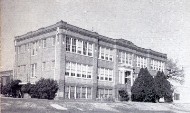




Milam County Historical Commission
Milam County, Texas
All credit for these articles go to
Susie Sansom-Piper and
the Rockdale Reporter
Milam County, Texas
All credit for these articles go to
Susie Sansom-Piper and
the Rockdale Reporter

Black History month articles
Written by Susie Sansom-Piper and
published in the Rockdale Reporter
Written by Susie Sansom-Piper and
published in the Rockdale Reporter
ON THE OTHER SIDE OF THE TRACKS, SERIES 8, PART 4
By SUSIE SANSOM-PIPER - Reporter contributor
Rockdale Reporter - 2015-02-26
Editor’s note: This is the fourth, and final, article in the eighth series of “On the Other Side of the Tracks,” a Black History Month series by former Rockdale resident, and longtime teacher, Susie Sansom-Piper.
The 60s: Changes to Rockdale, Nation
“Oh, there’s been times that I thought I couldn’t last for long,
But now I think I’m able to carry on.
It’s been a long time coming
But I know a change is gonna come.” — Sam Cooke
In spite of the restlessness and turmoil that was occurring in most southern states in the 1960s, the community “on the other side of the tracks” continued with no confrontations, nor negative incidents.
The cooperative spirit and unity still remained, although separatism in eating places still visible.
The “chicken roost” for seating was yet available in theaters, and swimming in the city pool was not allowed. The people of this town still retained a state of stability or a “wait and see” attitude as time progressed.
Then came the Civil Rights Act of 1964. It ended unequal application of voter registration requirements and segregation.
Aycock High school did not integrate immediately, but continued with a “patient listening” ear as preparations were made by the local school board to integrate in the near future.
Four terms continued before there was complete integration. The change was gradual, but remaining grades continued to bring pride to the community “on the other side of the tracks.”
The graduating class of 1960 produced: Dennis L. Brooks, minister and founder of the school of religion, which is now located on the former “old” Aycock property. Gladys McKee Norwood, Bobbie N. Richards-Castleberry and Johnnie D. Sanders Banks, educators. L. C. Richards, Alcoa and credit union board; and Lora Lee Turner Hatfield, Registered Nurse.
From 1961: Zelma Marie Mitchell- Simpson, model; Elma Lee Moultrie-Jackson, postal service manager, Alice K. Sanders, Registered Nurse.
From the class of 1962: Willie Lee Majors, real estate business; Clara Faye Clark-Brooks, school of religion; Oliver Eugene Norwood, x-ray technologist; Hope Cooke Wright, social service technician. Marie Estelle Fair-Clark, Registered Nurse; Daisy Majors, hospital secretary; Delores J. Phillips-Beaseley, educator.
The Class of 1964 included: Emma J. Douglas-Johnson, educator; Leroy Phillips, barber and Alcoa (now city council member); Lon L. Williams, Banking Services, rancher (now city building inspector). Patricia G. Jones, cancer researcher; John F. Williams, engineering.
The Class of 1965 wrote Aycock High School’s final chapter and included: Jessie Lee Brooks, Gloria N. Crawford-Majors, Arthur Ray Dykes, Charles Avery Dykes, Curtis Johnson, Bertha Louise Mack-Goodwin, Patricia Lynn McDaniel. Bettie Jean Miller Page, college secretary; Joyce Nealy Haywood, Clifford Anthony Norwood, armed services career; Earnest W. Smith, educator; Doris Robertson Phillips (varied).
1966 was the year of change. Freedom of choice was given in elementary grades and sixth grade was transferred to middle school. The high school was completely integrated. Remaining elementary grades continued to study at Aycock until May 1967.
SURVEY — All agreed that the first days were traumatic and that they were afraid.
Only a few were faced with the “N” word. This included “only” one teacher, who persisted in often using this word in her classroom.
There were fond memories of the late principals Ernie Laurence and Travis Grindle.
A brief survey of early integration was made.
These were some of the comments: “They were always so positive. We were always encouraged by our athletic coaches. They stressed pride, Endurance, performance and overall conduct.”
“We had no problem with the learning process, for our former Aycock teachers gave us a good foundation.”
“We learned how to accept one another, so even today, we are good friends.”
“We only remember one major incident. Weapons were displayed, but we ended things quietly and quickly.”
“Special thanks to Joyce Bayless, our high school counselor. She truly had a gift to help others to reach their greatest potentials.”
This is a master tribute to Rockdale, a small town where everybody is somebody.
A change did come! The tracks still remain, but only “for freight trains to rumble through, and a crossing for the interchange of communities. The unity is evident, for there exist “a spirit of unity, friendship, and cooperation “on both sides of the tracks.”
.
By SUSIE SANSOM-PIPER - Reporter contributor
Rockdale Reporter - 2015-02-26
Editor’s note: This is the fourth, and final, article in the eighth series of “On the Other Side of the Tracks,” a Black History Month series by former Rockdale resident, and longtime teacher, Susie Sansom-Piper.
The 60s: Changes to Rockdale, Nation
“Oh, there’s been times that I thought I couldn’t last for long,
But now I think I’m able to carry on.
It’s been a long time coming
But I know a change is gonna come.” — Sam Cooke
In spite of the restlessness and turmoil that was occurring in most southern states in the 1960s, the community “on the other side of the tracks” continued with no confrontations, nor negative incidents.
The cooperative spirit and unity still remained, although separatism in eating places still visible.
The “chicken roost” for seating was yet available in theaters, and swimming in the city pool was not allowed. The people of this town still retained a state of stability or a “wait and see” attitude as time progressed.
Then came the Civil Rights Act of 1964. It ended unequal application of voter registration requirements and segregation.
Aycock High school did not integrate immediately, but continued with a “patient listening” ear as preparations were made by the local school board to integrate in the near future.
Four terms continued before there was complete integration. The change was gradual, but remaining grades continued to bring pride to the community “on the other side of the tracks.”
The graduating class of 1960 produced: Dennis L. Brooks, minister and founder of the school of religion, which is now located on the former “old” Aycock property. Gladys McKee Norwood, Bobbie N. Richards-Castleberry and Johnnie D. Sanders Banks, educators. L. C. Richards, Alcoa and credit union board; and Lora Lee Turner Hatfield, Registered Nurse.
From 1961: Zelma Marie Mitchell- Simpson, model; Elma Lee Moultrie-Jackson, postal service manager, Alice K. Sanders, Registered Nurse.
From the class of 1962: Willie Lee Majors, real estate business; Clara Faye Clark-Brooks, school of religion; Oliver Eugene Norwood, x-ray technologist; Hope Cooke Wright, social service technician. Marie Estelle Fair-Clark, Registered Nurse; Daisy Majors, hospital secretary; Delores J. Phillips-Beaseley, educator.
The Class of 1964 included: Emma J. Douglas-Johnson, educator; Leroy Phillips, barber and Alcoa (now city council member); Lon L. Williams, Banking Services, rancher (now city building inspector). Patricia G. Jones, cancer researcher; John F. Williams, engineering.
The Class of 1965 wrote Aycock High School’s final chapter and included: Jessie Lee Brooks, Gloria N. Crawford-Majors, Arthur Ray Dykes, Charles Avery Dykes, Curtis Johnson, Bertha Louise Mack-Goodwin, Patricia Lynn McDaniel. Bettie Jean Miller Page, college secretary; Joyce Nealy Haywood, Clifford Anthony Norwood, armed services career; Earnest W. Smith, educator; Doris Robertson Phillips (varied).
1966 was the year of change. Freedom of choice was given in elementary grades and sixth grade was transferred to middle school. The high school was completely integrated. Remaining elementary grades continued to study at Aycock until May 1967.
SURVEY — All agreed that the first days were traumatic and that they were afraid.
Only a few were faced with the “N” word. This included “only” one teacher, who persisted in often using this word in her classroom.
There were fond memories of the late principals Ernie Laurence and Travis Grindle.
A brief survey of early integration was made.
These were some of the comments: “They were always so positive. We were always encouraged by our athletic coaches. They stressed pride, Endurance, performance and overall conduct.”
“We had no problem with the learning process, for our former Aycock teachers gave us a good foundation.”
“We learned how to accept one another, so even today, we are good friends.”
“We only remember one major incident. Weapons were displayed, but we ended things quietly and quickly.”
“Special thanks to Joyce Bayless, our high school counselor. She truly had a gift to help others to reach their greatest potentials.”
This is a master tribute to Rockdale, a small town where everybody is somebody.
A change did come! The tracks still remain, but only “for freight trains to rumble through, and a crossing for the interchange of communities. The unity is evident, for there exist “a spirit of unity, friendship, and cooperation “on both sides of the tracks.”
.